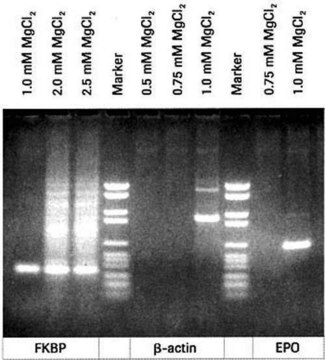M4880
Magnesium chloride
BioReagent, suitable for insect cell culture, ≥97.0%
Sinónimos:
Magnogene
About This Item
Productos recomendados
Línea del producto
BioReagent
Nivel de calidad
Análisis
≥97.0%
formulario
powder
técnicas
cell culture | insect: suitable
mp
714 °C (lit.)
solubilidad
water: 468.7 g/L at 20 °C
densidad
2.32 g/mL at 25 °C (lit.)
cadena SMILES
Cl[Mg]Cl
InChI
1S/2ClH.Mg/h2*1H;/q;;+2/p-2
Clave InChI
TWRXJAOTZQYOKJ-UHFFFAOYSA-L
¿Está buscando productos similares? Visita Guía de comparación de productos
Aplicación
- as a metal cofactor supplement in the terminal deoxynucleotidyl transferase (TdT) reaction
- as a component of Tris assay buffer to prepare substrate stocks for /-N-Acyl lysine substrate screening
- as a component of low-calcium differentiation medium for keratinocyte differentiation
Código de clase de almacenamiento
13 - Non Combustible Solids
Clase de riesgo para el agua (WGK)
WGK 1
Punto de inflamabilidad (°F)
Not applicable
Punto de inflamabilidad (°C)
Not applicable
Equipo de protección personal
Eyeshields, Gloves, type N95 (US)
Certificados de análisis (COA)
Busque Certificados de análisis (COA) introduciendo el número de lote del producto. Los números de lote se encuentran en la etiqueta del producto después de las palabras «Lot» o «Batch»
¿Ya tiene este producto?
Encuentre la documentación para los productos que ha comprado recientemente en la Biblioteca de documentos.
Los clientes también vieron
Protocolos
Summary application report for analysis of moisture in Magnesium chloride
Nuestro equipo de científicos tiene experiencia en todas las áreas de investigación: Ciencias de la vida, Ciencia de los materiales, Síntesis química, Cromatografía, Analítica y muchas otras.
Póngase en contacto con el Servicio técnico





